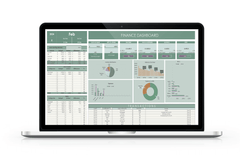So, you’ve figured out your risk profile—whether you’re a Chill Investor, a Balanced Babe, or a Go-Getter. But what’s next? How do you actually build an investment portfolio that reflects who you are and what you want to achieve? The answer lies in asset allocation, the art and science of dividing your investments among different asset classes to balance risk and reward.
But don’t worry, we’re not getting into complicated finance speak. Think of asset allocation like putting together the perfect outfit—you need the right mix of pieces to match your style and the occasion. Let’s dive into how you can create a balanced portfolio that suits your financial goals, risk tolerance, and timeline.

What Is Asset Allocation, and Why Does It Matter?
Asset allocation is all about spreading your money across different types of investments—or asset classes—like stocks, bonds, and cash. The goal? To find the right mix that helps you achieve your financial goals while managing your risk.
Imagine you’re going to a big event. You wouldn’t just throw on a pair of jeans and a t-shirt, right? You’d probably mix and match—a dress, some accessories, maybe a pair of heels. That’s how asset allocation works. You don’t want all your money in one place (or one outfit) because if something goes wrong, like the stock market taking a dip, you don’t want your entire investment to be affected.
By diversifying—spreading your investments across different asset classes—you reduce the risk of losing money while still giving yourself a chance to earn good returns.
The Main Asset Classes
Before you start building your portfolio, let’s break down the main asset classes you’ll be working with. Each has its own vibe and level of risk.
1. Stocks (Equities)
- Vibe: Stocks are like the trendy, high-fashion pieces in your wardrobe—high risk, high reward. When you buy a stock, you’re buying a piece of a company. If the company does well, your stock’s value goes up. If it doesn’t, your stock’s value can drop.
- Risk Level: Higher risk, but also the potential for higher returns.
- Who It’s For: Go-Getters and Balanced Babes who can handle some volatility for the chance of bigger rewards.

2. Bonds (Fixed Income)
- Vibe: Bonds are the comfy, reliable pieces in your closet—think classic jeans or a little black dress. When you buy a bond, you’re essentially lending money to a company or government, and they pay you back with interest.
- Risk Level: Lower risk, with steady, but generally lower, returns.
- Who It’s For: Chill Investors who value stability, but also Balanced Babes who want to add some security to their portfolio.
3. Cash and Cash Equivalents
- Vibe: Cash is like your go-to basics—safe and always in style. This includes money in your savings account, money market funds, or certificates of deposit (CDs).
- Risk Level: Very low risk, but also very low returns.
- Who It’s For: Chill Investors or anyone who wants to keep part of their portfolio super safe.
4. Real Estate
- Vibe: Real estate is the investment equivalent of a statement piece—bold, with the potential to make a big impact. You can invest directly in property or through Real Estate Investment Trusts (REITs), which are like buying stocks in real estate companies.
- Risk Level: Can vary, but generally moderate risk with potential for good returns.
- Who It’s For: Balanced Babes and Go-Getters looking for a mix of income and growth.
5. Cryptocurrencies
- Vibe: Crypto is like that edgy, experimental piece in your closet—super trendy, but with the potential to be a hit or miss. Cryptocurrency like Bitcoin or Ethereum is digital money that can be highly volatile.
- Risk Level: Very high risk, with the potential for very high returns (or losses).
- Who It’s For: Go-Getters with a high risk tolerance who are comfortable with the wild ride.
How to Build a Balanced Portfolio
Now that you know the main asset classes, it’s time to build your portfolio. Here’s how to create a balanced mix based on your risk profile.
1. The Chill Investor’s Portfolio (Conservative)
If you’re a Chill Investor, you value stability over big gains. You want to protect your money and aren’t interested in riding the market’s ups and downs. Your portfolio will lean heavily on bonds and cash, with a small slice of stocks for some growth.
Example Allocation:
- 20% Stocks: To give you some growth potential without too much risk.
- 60% Bonds: For steady, reliable income.
- 20% Cash: For safety and liquidity.
What It Looks Like: Think of this as your go-to weekend outfit—comfortable and dependable, but with a little flair.
2. The Balanced Babe’s Portfolio (Moderate)
As a Balanced Babe, you’re all about finding that middle ground. You want your money to grow, but you also want some security in case the market gets rocky. Your portfolio will have a healthy mix of stocks and bonds, with maybe a touch of real estate or cash.
Example Allocation:
- 60% Stocks: For growth and to take advantage of the market’s potential.
- 30% Bonds: To balance out the risk from your stocks.
- 10% Real Estate/Cash: For some extra stability or opportunities.
What It Looks Like: This is like your favorite outfit for a night out—stylish but practical, with just the right amount of edge.

3. The Go-Getter’s Portfolio (Aggressive)
If you’re a Go-Getter, you’re all about chasing those big returns. You’re okay with taking on more risk because you know it could pay off in the long run. Your portfolio will be mostly stocks, with a sprinkling of riskier assets like crypto, and a tiny bit of bonds for good measure.
Example Allocation:
- 80% Stocks: For maximum growth potential.
- 10% Cryptocurrencies: For the potential big wins (but also big risks).
- 10% Bonds/Real Estate: Just to have a small safety net.
What It Looks Like: Picture this as your statement-making outfit—bold, daring, and ready to turn heads.
The Power of Diversification
No matter your risk profile, diversification is your best friend. It’s like having a wardrobe with all the essentials plus a few standout pieces. When one part of your portfolio (or outfit) isn’t working, the others can help balance it out.
How to Diversify:
- Across Asset Classes: Don’t put all your money in one type of investment. Spread it out across stocks, bonds, real estate, and cash.
- Within Asset Classes: Even within each category, mix it up. For example, in stocks, you might invest in both tech companies and consumer goods, or in both U.S. and international markets.
Rebalancing: Keeping Your Portfolio in Check
Just like you’d update your wardrobe for a new season, you need to rebalance your portfolio every now and then to make sure it still aligns with your goals and risk tolerance.
When to Rebalance:
- Annually or Semi-Annually: Check in on your portfolio at least once a year to see if your allocations are still where you want them.
- After Major Life Changes: If you’ve had a big change in your life—like a new job, buying a house, or having a baby—you might need to adjust your portfolio.
How to Rebalance:
- Sell and Buy: If one part of your portfolio has grown too much (like stocks in a bull market), sell some of those and buy more of another asset (like bonds) to get back to your target allocation.
- Automatic Rebalancing: Some investment platforms offer automatic rebalancing, which takes care of this for you.

The Bottom Line: Make Your Portfolio Work for You
Building a balanced portfolio is like putting together a perfect outfit—one that makes you feel confident and ready to take on the world. By understanding your risk profile and knowing how to mix and match different asset classes, you can create an investment strategy that’s tailored to your financial goals and comfort level.
Remember, investing is a journey. Your portfolio doesn’t have to be perfect right away. Start where you are, keep learning, and make adjustments as you go. With the right mix, you’ll be well on your way to making your money work for you, now and in the future.
Stay tuned for more tips on how to grow your investment wardrobe, manage your money, and achieve your financial dreams!





